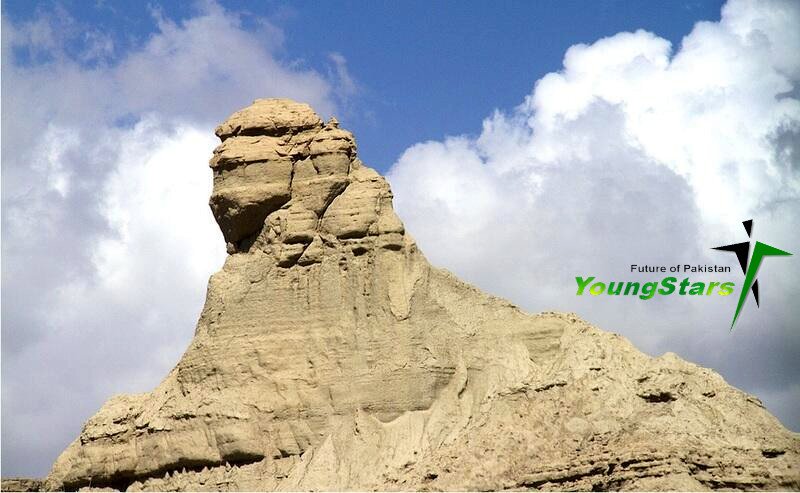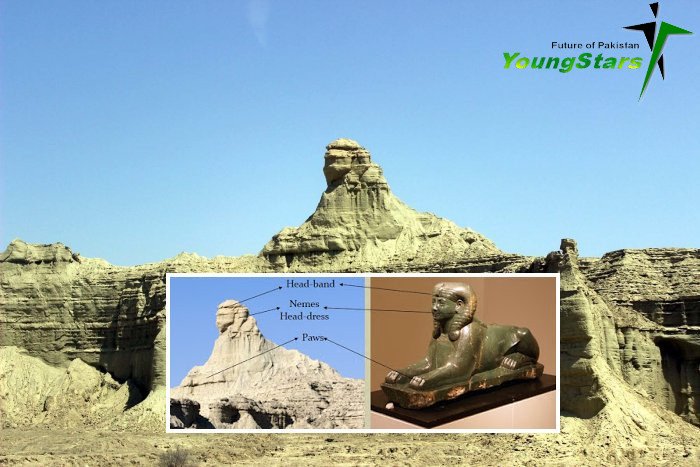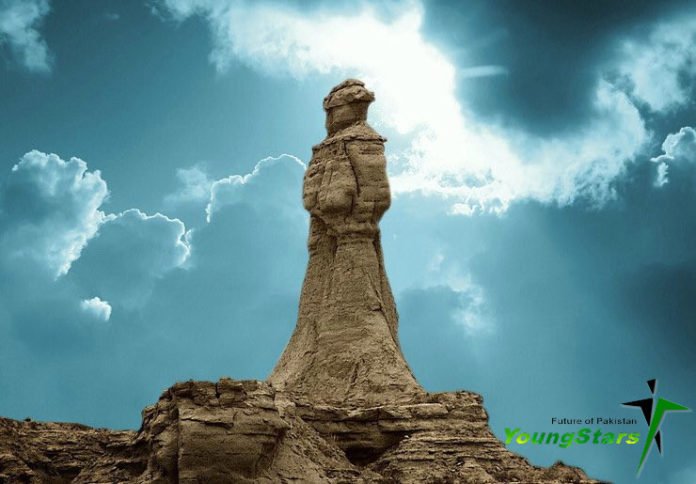The ruined, rocky landscape of the Makran coastal strip of southern Balochistan, Pakistan, is an architectural gem that has been unnoticed for centuries.

The Balochistan Sphinx, as it is known, came to the public’s attention only after the inauguration of Makran Coastal Highway in 2004, which connects Karachi with the port town of Gwadar on Makran coast. Passing through the four-hour, 240-km-long hilly trails through the wandering valleys of Karachi and Karachi, travelers are taken to Hangul National Park, where the Balochistan Sphinx is located.
The Balochistan sphinx
According to journalists, the Balochistan sphinx is routinely passed as a natural structure, although no archaeological survey has been conducted at the site. If we look for the properties of this structure as well as the surrounding complexes, it is often difficult to admit that it was formed by natural forces. Rather, this site looks like a huge, rock-cut, architectural complex.
A perfunctory glance at the impressive statue reveals that the sphinx has a well-defined jawline, and facial features, such as the eyes, nose, and mouth, which are placed in proper proportion to each other.
It seems that the sphinx is dressed in a headdress that resembles the headdress of Pharaoh’s Nemes of Egypt. The Nemes headdress is a striped headcloth that covers the head and back of the head. It has two large, prominent, flaps that hang behind the ears and in front of the shoulders. Ear-flaps can be interpreted as Balochistan sphinx as well as some striped markings. Above the forehead of the sphinx is a horizontal groove, which resembles the Pharaoh’s headband in which the Nemes head-dress is in place.
Anyone can easily make sphinx attachment offers, which end up in the most well-appreciated claws. It is difficult to see how nature could have erected a statue that, like the legendary beast, is surprisingly accurate.
The structure of sphinx-temple

Nearby Balochistan Sphinx is another important structure. From a distance, it seems like a Hindu temple (like the southern Hindu one), which has Mandapa (entrance hall) and a Vimana (temple top). The upper part of the Vimana appears to be missing. The Sphinx is leaning in front of the temple, acting as guardian of the sanctuary.
In Greece, the Sphinx had a woman’s head, eagle’s wings, a lioness’s body, and according to some, a snake’s tail. The magnificent sculpture of the Sphinx of Naxos stood on a magnificent ionic column in the Holy Oracle of Delphi, serving as the site’s protector.
Are you interested to read? Pakistan “a Journey from Terrorism to Tourism”
In Indian art and sculpture, the Sphinx is called Porsche Mariga (in Sanskrit, the ‘human animal’), and its primary status was near the gateway to the temple, which served as the guardian of the sanctuary. However, the sphinx was erected in the compound of the temple near the entrance (Gopuram), the halls (Mandapa) and the central shrine (Garba Gharaha).
Raja Deekshithar identified 3 basic forms of Indian sphinx:
- A crouching sphinx that has a human face, but has some lion features such as a mane and long ears.
- An evergreen or leaping sphinx with a full human face.
- One half straight or completely straight, sometimes with mustaches and long beard, often worshiping a Shiva-linga.
Sphinx also exists in Buddhist architecture in Southeast Asia. In Myanmar, they are called Manusiha (from Sanskrit Manu-Simha, which means male lion). They are shown in a cat-like currency at the corner of Buddhist stupas. They wear earrings, topping crowns and have feathers on their front limbs.
Therefore, throughout the ancient world, the Sphinx acted as guardians of sacred places. Perhaps not accidentally, Balochistan’s sphinx is also protecting a temple-like structure. This shows that the site was built according to the principles of sacred architecture.
A closer look at the Balochistan Sphinx Temple has revealed clear evidence of pillars carved on the boundary wall. The entrances of the temple are visible behind a pile of sediments or termites. To the left of the entrance can be a tall, sculptured, subsidiary structure. On the whole, there can be little doubt that it is a massive, man-made, rock-cut monument of an ancient antique.
Interestingly, it seems that on both sides of the entrance, two memorial statues stand on the part of the Sphinx Temple.
The painters are largely lost, making them difficult to identify. But it looks like the figure on the left might be Kartikeya (Skanda / Morgan) with a spear. And the figure on the right, a moving Ganesha. Coincidentally, both Kartikeya and Ganesha are Shiva’s sons, which means that the temple complex could have been dedicated to Shiva.
Although identity is speculative at this stage, the presence of sculptured figures on its map gives it more weight due to its man-made structure.
Sphinx – The structure of the Temple suggests that it may be Gopuram, the inner tower of a temple. Sphinx – Like the temples, gopurams are usually flat-topped. In Gopurams, there is a row of ornamental Kalasams (stone or metal pots) arranged on top. From a careful study of the Flat Top Sphinx Temple, you can know many ‘spikes’ from above, which are a line of Kalasams, covered with sediment or termite mounds.
The Sphinx-Temple is known to be connected to the outer boundary and Gopuram is connected to the boundary wall of a temple. The Gopurams also include the huge sculpted figures of dvarapalas, namely the door guardians and it is noted, the Sphinx-Temple appears to have two carved figures, just above its entrance.
A towering structure on the left of the sphinx temple may be another Gopuram. This shows that there may be four gopurams in the cardinal directions leading to the central courtyard, where the central site of the temple complex was built. This type of temple architecture is quite common in the southern Indian temples.
The Sphinx-Temple Platform

The upraised platform on which the Sphinx and the Temple are located, it seems to have a pillar, niche, and a balanced pattern that extends throughout the upper part of the platform. There may also be certain doors that lead to the chambers and halls under the Sphinx Temple.
It is believed by many, including mainstream Egyptian experts such as Mark Lehner, that even under the great Sphinx of Giza, there may be rooms and paths. It is also interesting to note that the Balochistan Sphinx and Sphinx – Temple is located on a high platform, just as Egypt’s sphinx and pyramids are built on the Giza Plateau overlooking the city of Cairo.
Another prominent feature of this site is a series of steps towards the higher platform. These measures appear at the same distance and the same height. The whole site gives the impression of a magnificent, stone-cut, architectural complex, which has been hollowed out by the elements and is covered with layers of sediment, which expose more intricate details of the sculpture.

Sedimentation on the site
The Makran coast of Balochistan is an earthquake-hit zone, which often generates a lot of tsunamis that erode entire villages. The earthquake was reported from the coast of Makran on November 28, 1945, and in some places the wave reached 13 meters, causing a tsunami.
Besides, several earthen volcanoes are scattered along the Makran coast, some of which are located in the Hingol National Park near the Hingol River Delta. The severe earthquake-triggered volcanic eruptions, amazing mud sloping and sinking the surrounding landscape. Occasionally, earthen volcanic islands appear in the Arabian Sea off the coast of Makran, dispersed by wave operations within a year.
The combined action of the tsunami, clay volcanoes, and termites can, therefore, be responsible for the construction of sediment on the site.
The age of these temples
The Indus valley civilization extends along the Makran coastline, and its oldest western archeological site is known as the Sutkagen Door, near the border of Iran. Statues carved from some temples and cliffs in the area, including the Sphinx-Temple complex, are, therefore, built thousands of years ago, or before the Indus period (c. 3000 BC). It is possible that this site was built in stages, and that some structures are very old, and some others have been relatively recent. However, dating rock-cut monuments is difficult in the absence of logs. If this site has readable logs that can be translated (another tricky suggestion, since the Indus script, has not yet been revealed), it may be possible to date some monuments. However, in the absence of logs, scientists will have to rely on data samples / human remains, architectural patterns, geological erosion patterns, and other indicators.
One of the permanent mysteries of Indian civilization is the idea of magnificent stone temples and monuments built since the third century BC.
The monuments cut from the rocks of the Makran coastal can provide the much-needed continuity between the architectural forms and techniques of the Indus period and the subsequent Indian civilization. It may have been on the hills of the Makran coast that the artisans of Sindh honored and perfected their skills, which were later transferred to Indian civilization.
Undoubtedly there is a virtual treasure trove of surprises discovered on the Makran coast of Balochistan. Unfortunately, these magnificent monuments, which have their origins in unknown antiquities, suffer from loneliness thanks to the terrifying levels of apathy. It seems that little effort has been made to acknowledge or restore them, and journalists routinely refer to them as ‘natural structures’.
This situation can only be avoided if international attention is drawn to these structures, and teams of archaeologists from around the world (as well as freelance spectators) use these memorable monuments for research, restoration, and promotion. The importance of these ancient monuments on the Makran coast can hardly be overstated. They can be great antiquities, and provide us with important clues to uncover the mysterious past of humanity.
To promote religious tourism in Pakistan KPK Govt is organizing the biggest Buddhism Gandhara Festival 2020 is coming soon. For more information please check, How to apply visit e-visa for Pakistan?





[…] the first century CE, Gandhara has become the center of a thriving school of sculpture and architecture. It has been very controversial at the beginning of the school, but it has both Indian and […]
[…] a lot of potentials. Talking to the Arab News Pakistan edition, she said, “Give the people of Baluchistan a chance, whether, in education, sports or any other field, they will prove […]
[…] The Buddhism architecture, Sphinx of Balochistan […]
[…] The Buddhism architecture, Sphinx of Balochistan […]
[…] The Buddhism architecture, Sphinx of Balochistan […]
… [Trackback]
[…] Read More on that Topic: youngstars.pk/2020/02/764/the-buddism-architecture-sphinx-of-balochistan/ […]
… [Trackback]
[…] There you can find 55972 more Info to that Topic: youngstars.pk/2020/02/764/the-buddism-architecture-sphinx-of-balochistan/ […]
… [Trackback]
[…] Info on that Topic: youngstars.pk/2020/02/764/the-buddism-architecture-sphinx-of-balochistan/ […]
… [Trackback]
[…] There you will find 73302 more Information on that Topic: youngstars.pk/2020/02/764/the-buddism-architecture-sphinx-of-balochistan/ […]
… [Trackback]
[…] Info to that Topic: youngstars.pk/2020/02/764/the-buddism-architecture-sphinx-of-balochistan/ […]
… [Trackback]
[…] Read More to that Topic: youngstars.pk/2020/02/764/the-buddism-architecture-sphinx-of-balochistan/ […]
… [Trackback]
[…] There you can find 53351 more Info to that Topic: youngstars.pk/2020/02/764/the-buddism-architecture-sphinx-of-balochistan/ […]
… [Trackback]
[…] Information on that Topic: youngstars.pk/2020/02/764/the-buddism-architecture-sphinx-of-balochistan/ […]
… [Trackback]
[…] Find More on that Topic: youngstars.pk/2020/02/764/the-buddism-architecture-sphinx-of-balochistan/ […]
… [Trackback]
[…] There you can find 90869 additional Information to that Topic: youngstars.pk/2020/02/764/the-buddism-architecture-sphinx-of-balochistan/ […]
… [Trackback]
[…] Info on that Topic: youngstars.pk/2020/02/764/the-buddism-architecture-sphinx-of-balochistan/ […]